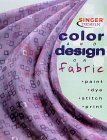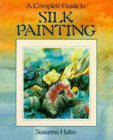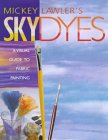The
Art of Faux : The Complete Sourcebook of Decorative Painted Finishes
by Pierre Finkelstein
Aimed at professionals and dedicated amateurs, The Art of Faux is packed
with gorgeous examples of faux finishes. Internationally acclaimed, award-winning
decorative painter and instructor Pierre Finkelstein covers every aspect
of the art form in tremendous detail, beginning with extensive specifics
on all tools, materials, supplies, and planning, and including preparation
and cleanup considerations. Each of the other 10 chapters concentrates
on a wide variety of faux finishes in different categories: marble, semiprecious
stone, limestone and sandstone, wood, patinas and textures, metals and
gilding, tile, organic materials (such as ivory, leather, and mother-of-pearl),
stenciling, and trompe l'oeil. There are even instructions for uncommon
faux finishes, such as bamboo, Delft tile, snakeskin, and damask, that
are not generally taught in other books on the subject. Every finish is
presented as a complete recipe, and the list of ingredients includes not
only paints, glazes, and tools, but also difficulty ratings and lists of
preparatory exercises for techniques that are part of the complete finish.
People seriously involved in any aspect of faux finishing--particularly
people considering careers in the field--should invest in the information-packed
The Art of Faux. Amazon.com
Paperback: 336 pages ; Dimensions (in inches):
0.75 x 10.92 x 8.43
Publisher: Watson-Guptill Pubns;
ISBN: 0823008584
Berberine
and Huangbo : Ancient Colorants and Dyes (British Library Studies in Conservation
Science, Vol 2)
by Peter J. Gibbs, Kenneth R. Seddon
Paperback: 64 pages ; Dimensions (in inches):
0.27 x 9.25 x 6.17
Publisher: British Library Pubns; (November
)
ISBN: 0712306498
Craft
of Natural Dyeing
by Jenny Dean
The
Art of Manipulating Fabric
by Colette Wolff
Batik
and Tie Dye Techniques
by Nancy Belfer
Paperback: 145 pages ; Dimensions (in inches):
0.39 x 9.21 x 6.49
Publisher: Dover Pubns; 3rd edition (August
1992)
ISBN: 0486271315
A
Complete Guide to Silk Painting
by Susanne Hahn
Paperback: 136 pages ; Dimensions (in inches):
0.45 x 10.25 x 8.30
Publisher: Search Pr Ltd; (January 1992)
ISBN: 0855327189 |
Fabric
Painting and Dyeing for the Theatre
by Deborah Dryden (Author)
Paperback: 424 pages ; Dimensions (in inches):
0.71 x 9.27 x 7.44
Publisher: Heinemann; (November 1993)
ISBN: 0435086243
Fabric
Dyeing & Printing
by Kate Wells
Mauve:
How One Man Invented a Color That Changed the World
by Simon Garfield
In 1856, while trying to synthesize artificial quinine, 18-year-old
chemistry student William Perkin instead produced a murky residue. Fifty
years later, he described the event: he "was about to throw a certain residue
away when I thought it might be interesting. The solution of it resulted
in a strangely beautiful color." Perkin had stumbled across the world's
first aniline dye, a color that became known as mauve.
"So what?" you might say. "A teenager invented a new color." As Simon
Garfield admirably points out in Mauve, the color really did change the
world. Before Perkin's discovery all the dyes and paints were colored by
roots, leaves, insects, or, in the case of purple, mollusks. As a result,
colors were inconsistent and unpredictably strong, often fading or washing
out. Perkin found a dye that would always produce a uniform shade--and
he pointed the way to other synthetic colors, thus revolutionizing the
world of both dyemaking and fashion. Mauve became all the rage. Queen Victoria
wore it to her daughter's wedding in 1858, and the highly influential Empress
Eugénie decided the color matched her eyes. Soon, the streets of
London erupted in what one wag called the "mauve measles."
Mauve had a much wider impact as well. By finding a commercial use for
his discovery--much to the dismay of his teacher, the great August Hofmann,
who believed there needed to be a separation between "pure" and "applied"
science--Perkin inspired others to follow in his footsteps: "Ten years
after Perkin's discovery of mauve, organic chemistry was perceived as being
exciting, profitable, and of great practical use." The influx of bright
young men all hoping to earn their fortunes through industrial applications
of chemistry later brought significant advances in the fields of medicine,
perfume, photography, and even explosives. Through it all, Garfield tells
his story in clever, witty prose, turning this odd little tale into a very
entertaining read. --Sunny Delaney - Amazon.com
Paperback: 242 pages ; Dimensions (in inches):
0.60 x 8.20 x 5.48
Publisher: W.W. Norton & Company;
ISBN: 0393323137 |
Mickey
Lawler's Skydyes : A Visual Guide to Fabric Painting
by Mickey Lawler, Rose Sheifer, Annie Nelson (Editor)
Renowned textile artist Mickey Lawler's exquisite hand-painted fabrics
are eagerly sought by quilters. Here she shares her amazing way with color
and design, instructing readers of any skill level how to paint cottons
to achieve remarkable scenic effects suggesting sunrises, sunsets, night
skies, storms, seas, landscapes, and gardens. Most of all she exhorts us
to have fun, to relax and develop a playful attitude toward our work, to
enjoy the serendipitous results these techniques produce. Strewn throughout
these vivid pages are gorgeous quilts by various artists utilizing Lawlor's
hand-painted fabrics. Also included is one brief project for turning your
own painted fabrics into a simple quilt. --Amy Handy
Paperback: 112 pages ; Dimensions (in inches):
0.36 x 11.02 x 8.53
Publisher: C & T Pub; 0 edition
ISBN: 157120072X |
Shibori:
The Art of Fabric Tying, Folding, Pleating and Dyeing
by Elfriede Moller
Paperback: 64 pages ; Dimensions (in inches):
0.26 x 10.24 x 8.28
Publisher: Search Pr Ltd; (November )
ISBN: 0855328959
Shibori
: The Inventive Art of Japanese Shaped Resist Dyeing - Tradition Techniques
Innovation
by Yoshiko; Rice, Mary Kellogg and Barton, Jane Wada, et al
(Paperback)
Tie
Dye! The How-To Book
by Virginia Gleser
Book Description: Learn the secrets of tie dying and create
your own beautiful fabrics. Tie dying is an ancient art form developed
in the Far East over a thousand years ago. This user-friendly book will
show you how to create seven unique and beautiful designs. Clear, simple
instructions, including photos of each stage of the tying and dying, will
guide you through the process. Full color photos show the stunning results
possible. Includes a source listing for permanent, high quality dyes.
Traditional Scottish Dyes
by Jean Fraser
Paperback: 192 pages ; Dimensions (in inches):
0.25 x 7.75 x 5.25
Publisher: Interlink Pub Group; (March )
ISBN: 0862415756
Out of Print - Try Used
Books
Scenic
Art for the Theatre
by Susan Crabtree, Peter Beudert
Book Description: Scenic Art for the Theatre is a visual and
written guide to the tools and techniques used in modern scene painting.
The authors guide the reader through the complex role of the scenic artist,
discussing his or her relationship with the scenic designer and production
staff; the variety of tools used in scenic artistry including paints, materials,
and surfaces; and the techniques, both traditional and non-traditional.
The book also includes a history of scenic artistry beginning with the
Renaissance and Baroque theatres through the Romantic theatre to the present
day Modern theatre.
Scenic Art for the Theatre is written in easy-to-understand language
for both the student and the professional. The tools and techniques sections,
complete with hints and how-to's, make this book a handy reference for
anyone studying or working in this field.
Paperback: 272 pages ; Dimensions (in inches):
0.64 x 10.99 x 8.46
Publisher: Focal Press; (March )
ISBN: 0240801873
Spin, dye & weave your own wool
by Molly Duncan
Out of Print - Try Used
Books











